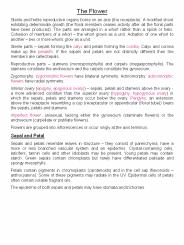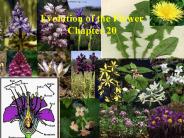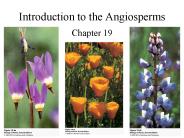Adnation PowerPoint PPT Presentations
All Time
Recommended
... number of parts, connation and adnation, insertion, and ovary position. ... relationship of the parts to each other, and degree of connation and/or adnation. ...
| PowerPoint PPT presentation | free to view
MORFOLOGI BUNGA 2 Bagian Bagian Bunga Pedicellus Receptaculum Periantium / Perigonium Androecium Stamen Gynaecium Pistillum Bagian-Bagian Bunga epicalyx The Main Part ...
| PowerPoint PPT presentation | free to download
The Flower and Sexual Reproduction Chapter 13 Significance of the Flower Flowers and fruit least affected by environment Appearance of flowers and fruits important to ...
| PowerPoint PPT presentation | free to download
The Flower Sterile and fertile reproductive organs borne on an axis (the receptacle). A modified shoot exhibiting determinate growth (the floral meristem ceases ...
| PowerPoint PPT presentation | free to download
ANGIOSPERM FAMILY
| PowerPoint PPT presentation | free to download
One Word Who am I? Photos (describe the family also) More Photos Lots of Photos 5 pt 5 pt 5 pt 5 pt 5 pt 10 pt 10 pt 10 pt 10 pt 10 pt 15 pt 15 pt 15 pt 15 pt 15 pt
| PowerPoint PPT presentation | free to download
MORFOLOGI BUNGA 3 Rumus Bunga Rumus ... (e.g., G1 = monocarpous) Kelopak 5 Sepal lepas Mahkota 5 petal lepas Stamen 10 sampai banyak Putik 1 karpel superus FLORAL ...
| PowerPoint PPT presentation | free to download
Real-Time Rendering of Plant Leaves, Lifeng Wang (Microsoft ... Up : petal connate to petal : ?? ??. Sp : sepal adnate to stamen : ???. ??? ???. Inflorescence ...
| PowerPoint PPT presentation | free to download
M I S Macrophyte Index Scheme (Wegher e Turin, 1987) Aquatic macrophytes can be considered good biological indicators of pollution because: they are sensitive to ...
| PowerPoint PPT presentation | free to view
Campanulids:Asterales: Campanulaceae(The Bellflower or Lobelia Family) Widespread in northern temperate and sub-tropical regions; also in the montane tropics
| PowerPoint PPT presentation | free to view
... * Pollen Grains Taxonomically useful Most families Many genera Some species Widely represented in fossil record Palynology Undergo mitosis within pollen ...
| PowerPoint PPT presentation | free to view
9. Almost Rosids to Rosids Santalales Lots of parasitism Polyacetylenes 1-seeded ovules, pendulous and free-central placentation Molecules In ours, flowers not ...
| PowerPoint PPT presentation | free to download
Angiosperms enclose their seeds in structures known as carpels, instead of lying ... papery. Simple fruit fleshy fruits. Berries- tomatoes, dates, and grapes ...
| PowerPoint PPT presentation | free to download
0;1;2;3;4;5;6;7;8;9;:;;; ;=; ;?A;B;C;D;E;F;G;H;I;J;K;L;M;N;O;P;Q;R;S;T;U;V; W;X;Y; ... ; ; ; ; ; ; ; ; ; ; ; ; ; ; ; ; ; ; ; ; ; ; ; ; ; ; ; ; ; ;P; ; ; ; ; ; ; ; ; ; ...
| PowerPoint PPT presentation | free to view
Diversity And Classification of Flowering Plants: Eudicots: Rosids Michael G' Simpson
| PowerPoint PPT presentation | free to view
white, yellow, pink. Dark spore print. black, purple, brown, red,rust, green ... Stalk base yellow. Cottony veil. Tricholomataceae. Clitocybe. Spore white (to ...
| PowerPoint PPT presentation | free to view
Flowers unisexual (plants dioecious) Tepals 7-11, distinct. Pollen ... Carp *, 7-8 , 1-2, 5-6, drupes. flowers. fruits. Amborella. Judd et al. (2002) ...
| PowerPoint PPT presentation | free to view
Primitive flower - blending of flower parts; spirally arranged. fossils, embryology, modern plants Degeneria. Carpel - primitive pistil. Carpel Formation ...
| PowerPoint PPT presentation | free to view
Commelinaceae -- the spiderwort family (42-50/500-700; cosmopolitan) Monocots II Habit herbs; somewhat succulent and with mucilaginous sap; stems somewhat jointed ...
| PowerPoint PPT presentation | free to download
Ericaceae -- the heather or blueberry family (116+/3,500; cospmopolitan) Dilleniidae Habit herbs, shrubs, or trees; often with evergreen leaves, some members (e.g ...
| PowerPoint PPT presentation | free to download
Flowers are actinomorphic often showy and nearly ... Inflorescence of 1-5 flowers peduncles arising from upper leaf ... open flower. Convulvulaceae buds ...
| PowerPoint PPT presentation | free to view
Welcome to our tour
| PowerPoint PPT presentation | free to view
Cold for most of the year due to summer stratification ... Arthropods. Crustaceans. Insects. Littoral Zone Littoral Invertebrates. Characteristics ...
| PowerPoint PPT presentation | free to download
Aceraceae -- the maple family (2/120; Mostly New and Old World temperates, plus tropics of s.e. Asia) Rosidae II Habit shrubs or trees Leaves palmately-veined, simple ...
| PowerPoint PPT presentation | free to download
Ranunculaceae Buttercup Family
| PowerPoint PPT presentation | free to view
Orchidaceae -- the orchid family (835/20,000-30,000; mostly tropics but also in temperate latitudes) Monocots I Habit herbs, terrestrial, often epiphytic ...
| PowerPoint PPT presentation | free to download
Caryophyllaceae-- the pink or carnation family (66-75/2,000; cosmopolitan with most in temperate and warm-temperate of Northern Hemisphere) Caryophyllidae
| PowerPoint PPT presentation | free to download
Introduction to the Angiosperms Chapter 19 Angiosperms- Anthophyta Autotrophic, but parasitic and saprophytic representatives. Enclosure of ovules within carpels.
| PowerPoint PPT presentation | free to download
Order Poales, family Bromeliaceae, Typhaceae, Eriocaulaceae, ... Andropogon gerardii. Sorghastrum nutans. Native Grass Species... Sporobolus heterolepis ...
| PowerPoint PPT presentation | free to view
Nymphaeaceae The Waterlily Family Nymphaeacea Genera Nymphaea - Waterlilies Nuphar - Spatterdocks Ondinea - Western Australia Victoria - South American Euryale ...
| PowerPoint PPT presentation | free to view
Like some sponges and corals, they form colonies of various shapes and sizes, ... all aquatic and are mostly marine, sessile, benthic animals, and are all filter ...
| PowerPoint PPT presentation | free to view
Coral-root orchid (Corallorhiza maculata), an interesting mycotrophic wildflower that grows in the shady conifer forests of San Diego County. The stem develops from a ...
| PowerPoint PPT presentation | free to download
Fruit caryopsis (achene, utricle, nut, or drupe), often shed together with enclosing bracts ... Fruit= cluster of achenes or follicles (rarely berries) (Floral ...
| PowerPoint PPT presentation | free to view
... free from subtending bracts; 2 ovules per cone scale, on top of scale (adaxial) ... scale, on top of scale (adaxial) or embedded in scale; cones ...
| PowerPoint PPT presentation | free to view
... turned upside down (resupinate) as it develops so the labellum is on the bottom ... connate, with the third petal (lip or labellum) usually elaborated in some way ...
| PowerPoint PPT presentation | free to view
Calyx 4-5 sepals, distinct or variously connate; zygomorphic ... Calyx modified into a pappus, extremely variable in features, maybe absent ...
| PowerPoint PPT presentation | free to view
Sarraceniaceae -- the pitcher plant family (3/15; Widespread in North America, ... with small stipules; glands in leaf axil or on adaxial side of leaf base ...
| PowerPoint PPT presentation | free to view
Inflorescences cymes (can appear ... Fruit aggregate of achenes [Floral formula: Ca 3 Co 3 A 6- G 6 ... Fruit achene or drupe [Floral formula: T 4 A 4 G 4 ] ...
| PowerPoint PPT presentation | free to view
Also used as street and other landscaping trees/shrubs. ... in all members of this family, is a very unique characteristic of this family. ...
| PowerPoint PPT presentation | free to view
Loranthaceae/Viscaceae -- the mistletoe family(ies) (67-85/1000; cosmopolitan, ... Leaves opposite and decussate, simple, entire, parallel-veined, leathery to ...
| PowerPoint PPT presentation | free to view
Inflorescences solitary or cymose (appearing raceme-like or head-like) ... Inflorescence corymb or raceme ... indeterminate as heads, racemes, or spikes ...
| PowerPoint PPT presentation | free to view









































